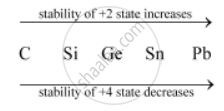Advertisements
Advertisements
प्रश्न
Discuss the pattern of variation in the oxidation states of C to Pb.
उत्तर १
The electronic configuration of group 14 elements is ns2 np2. Therefore, the most common oxidation state exhibited by them should be +4. However, the +2 oxidation state becomes more and more common on moving down the group. C and Si mostly show the +4 state. On moving down the group, the higher oxidation state becomes less stable. This is because of the inert pair effect. Thus, although Ge, Sn, and Pb show both the +2 and + 4 states, the stability of the lower oxidation state increases and that of the higher oxidation state decreases on moving down the group.
| Group 14 element | Oxidation state |
| C | +4 |
| Si | +4 |
| Ge, Sn, Pb | +2, +4 |

उत्तर २
The common oxidation states are +4 and +2. Stability of +4 oxidation state decreases from C to Pb. Details can be seen from the text part.
APPEARS IN
संबंधित प्रश्न
Explain the difference in properties of diamond and graphite on the basis of their structures.
Explain the following reaction.
Silicon is heated with methyl chloride at high temperature in the presence of copper.
Classify the following oxide as neutral, acidic, basic or amphoteric:
Al2O3
Classify the following oxide as neutral, acidic, basic or amphoteric:
PbO2
Write suitable chemical equations to show the nature of the following oxide.
SiO2
Write suitable chemical equations to show the nature of the following oxide.
Al2O3
Write suitable chemical equations to show the nature of the following oxide.
PbO2
Which of the following is a Lewis acid?
Catenation i.e., linking of similar atoms depends on size and electronic configuration of atoms. The tendency of catenation in Group 14 elements follows the order:
Explain the following:
Silicon forms \[\ce{SiF^{2-}6}\] ion whereas corresponding fluoro compound of carbon is not known.
Explain the following:
CO2 is a gas whereas SiO2 is a solid.
The +1 oxidation state in group 13 and +2 oxidation state in group 14 becomes more and more stable with increasing atomic number. Explain.
Carbon and silicon both belong to the group 14, but inspite of the stoichiometric similarity, the dioxides, (i.e., carbon dioxide and silicon dioxide), differ in their structures. Comment.
Explain the following:
Why does the element silicon, not form a graphite like structure whereas carbon does.
Stannous chloride solution when kept in the air turns milky due to the formation of ______.
\[\ce{SiCl4 ->[H2O] (A) ->[\Delta] (B) ->[Na2CO3][heat] (C)}\]. The Compound C is ______.
Which one of the following compounds of Group–14 elements is not known?
